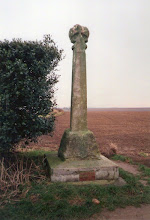There is so much to love about the festive season – family (tricky relations ... maybe less so!), holidays, excellent nosh, left-overs ... and time to get stuck into wargaming projects.
The main focus of this Christmas break has been consolidating my collection of (mainly scratch built) 15mm terrain for my WW1 Sinai, Palestine and Mesopotamia gaming with TFL's
If the Lord Spares Us ruleset. Rules errata and list of scenarios
here.
Here is a selection of the pieces I have created so far:

1. Entrenchments and wire
I have created stands of a simple wire entanglement (see below) using copper wire coiled around a rod, glued to a base and with tooth pick uprights. A dozen of these probably took no more than an hour from start to finish - I'm happy with the overall result from that fairly minimal effort.
 |
| Barbed wire entanglements were constructed using cold copper wire (some 1.5mm electrical wire stripped of its plastic insulation). |
I am planning on using a felt base mat with a combination of hex-terrain underneath the mat to create different elevations and simple multi-layer hills made of cork. Trenches will be represented using Battlefield Accessories' Hasty Entrenchments as seen in this previous post. While it would be great to have trenches dug into terrain boards, I prefer the flexibility of this arrangement.
 |
| Battlefield Accessories 'Hasty Entrenchments' - 12 per pack with each piece individual. |
My reading so far suggests that strongpoints and redoubts used by the Ottoman forces in the campaign were largely limited fairly thinly wired trench systems. Bunkers were rarely used with cement being a rare resource in the desert. It's hard to discuss such defensive positions without briefly recalling
Tank Redoubt - the shell of a destroyed Mark 1 tank used by the Ottoman troops as a strong point at the Second Battle of Gaza (19 April 1917) – maybe an Irregular Miniatures Mk 1 could be used for this!

2. Buildings
I have created a series of adobe buildings for villages and oasis buildings. I have used
Matakishi's building technique using 6mm floor tile cork for the base structure.
This time I've experimented with improving the texturing of the outside by using a layer of
Woodland Scenics plaster cloth over the cork. I find the resulting finish worth the extra effort.

I've then painted the dry plaster cloth with Vallejo Iraqui Sand, followed by a wash of dark brown and a dry brush of off white to pick up the highlights. The result, in my opinion is a very passable building that is cheap, easy to make.
3. Wadi
The dictionary definition for wadi is:
- the bed or valley of a stream in regions of southwestern Asia and northern Africa that is usually dry except during the rainy season and that often forms an oasis : gully, wash
- a shallow usually sharply defined depression in a desert region
While some wadi that were encountered during the desert campaigns of 1915-18 were obviously of the larger type – deep ravines and valleys cut by a seasonal riverbed, these are tricky to easily represent on the tabletop.
To represent the smaller wadi that were common during this campaign, I have adopted a fairly simple dry river bed made up of textured canvas (from an old terrain mat I cut up) with gravel lining the edges. I scattered a little flock over this and gave it a solid spray with matt varnish.
 |
| Simple wadi terrain |
4. Oasis
The oasis and desert wells were locations of strategic importance during this campaign – obviously, due to the limited water supplies carried by the troops. Ion Idriess, in his memoir of his time in Gallipoli, Sinai and Palestine with the 5th Australian Light Horse (
The Desert Column), provides many accounts of riding considerable distances to engage the Ottoman forces with only a canteen of water to last a day or more – often shared with their horses! The accounts of infantry mad with thirst is horrible to contemplate.
The groundwork for the oasis was built up using acrylic brown mastic over a textured polystyrene sheet with gravel, flocking and some small stones around the edge. I added some dry grass tufts for a bit of character. The water is just painted at present.
This project has finally provided a use for a pack of 100 plastic palm trees purchased from a supplier on Ebay (for only a few dollars). They could do with a paint job, but don't look too bad.
5. Hills
I've opted for a simple hills made up of layers of flocked and painted 6mm cork tile in the style of those pioneered by Major General Tremorden Rederring's Colonial-era Wargames
website - sadly no longer being maintained. I formed the shapes by breaking the cork sheet by hand, giving a rough edge that paints up well as exposed rock and overcomes the issue of getting miniatures to stand up on slopes.
I will also use the wooden hex terrain which I have used for Great War Spearhead II – see this
previous post.
6. Terrain mat
This is still a work in progress. I'm planning on using a felt mat from a local (Melbourne, Australia) supplier of felt:
http://www.jjdavies.com.au/decorative-felts
JJ Davies can provide felt in widths of up to 180cm and will cut to order. I'll provide a review once I have purchased it. I will probably use colour # 311 or 318 and may use a few patches of spray paint on it to give some variation. More to follow on this.
That's about it for now. The next step is to get to work on the mounted troops (Australian Light Horse, Imperial Camel Corps and Ottoman cavalry), artillery and some irregular Arab infantry. And, maybe some gaming! Ha ha.
Thanks for dropping by – I hope the festive season has been good to you and thanks for your support in 2015.





















































